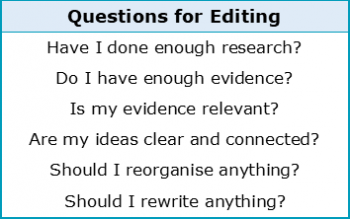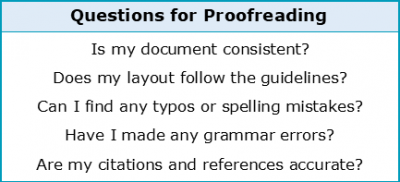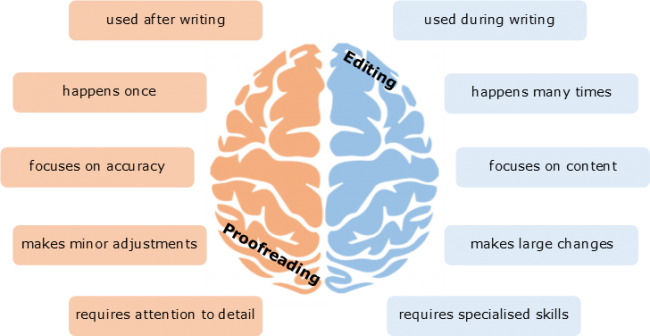How is editing different from proofreading?

This is the second of four chapters about Editing and Proofreading. To complete this reader, read each chapter carefully and then unlock and complete our materials to check your understanding.
– Explore the differences between professional and personal editing services
– Highlight how editing and proofreading differ from each other
– Provide example questions and diagrams to assist learning
Chapter 2
You will likely be reminded while at university to edit and proofread carefully during the writing process, but many students admit to not clearly understanding the differences between these two writing skills. Editing and proofreading are however quite different from each other, being necessary at different stages during the creation of an academic essay or presentation.
Before going into detail about the various functions of editing and proofreading and how they differ, it’s worth noting here that there’s a distinct variation in the meaning of these concepts when offered as a professional service. Much like the content-improving services that are offered on Academic Marker, students are often able to pay for professional editors and proofreaders to improve their work for them. Demand for such a service is especially common for non-native speakers of English who should therefore understand the key differences between each service before committing to a paid contract.
What is professional editing?
As a professional service, editing is the most thorough, detailed and expensive improvement of your work possible as it will generally include both editing and proofreading services. Following payment and an agreed upon deadline, a professional editor will aim to improve the quality of your writing and argumentation, enhance your language use, clarify any unclear expressions, and remove all errors and inconsistencies. Professional editors will consider the overall style, content and purpose of your assignment and improve your writing (and hopefully your grades) by using specialised knowledge, creativity and research. Depending on what you initially submitted, such editors may therefore have to rewrite large sections of your text.
Please note, although pay-for editing services certainly exist, do remember to consult your tutor before submitting your work to a company such as Academic Marker – just in case doing so contravenes regulations of plagiarism or collusion.
What is personal editing?
It’s often not necessary or recommended for students to pay someone else to do their editing for them. In fact, students that learn by practising such skills are often those that end up having the most academic success in the long run. Considered to be a right-brain activity, personal editing is different from proofreading in that it’s usually necessary to make edits numerous times throughout the writing process. Intended to improve the content of an assignment and not the minor details such as spelling and grammar, a student may ask themselves (and answer) the following questions during the editing process:

A good academic should never be afraid of deleting or rewriting their work, even if those sentences, paragraphs or sections have taken considerable time. As was explained in Chapter 1, very few people are able to write with absolute clarity during the first draft. Your writing will almost certainly improve with each edit you make.
How is proofreading different to editing?
While your academic tutor will not make direct changes to your work as an external company would, your tutor will likely proofread your work and return it to you with suggestions for editing. Using an error-correction code, tutors are there to check that students are following the specific rules and guidelines of the assignment, that formatting is as specified, that rules of grammar, spelling, and punctuation are accurate, and that the layout is consistent throughout. While editing is more concerned with content, as a left-brain skill proofreading is more focussed on technical accuracy. As such, the technical elements that a writer will look for during the proofreading process cannot be checked until the assignment is almost complete. Proofreading is therefore necessary only after the final draft is fully edited.
While your tutor may highlight any issues you have in your draft using an error-correction code and a professional proofreader should make such changes for you, it’s also important as a student that you’re able to carefully proofread your own work shortly before the final submission. When proofreading, ask yourself (and answer) the following questions to guarantee proofreading success:

To summarise the differences between these two writing skills, our academics have created a quick diagram for you to follow below:

Having now discussed the importance of editing and proofreading as well as the differences between these two skills, Chapters 3 and 4 will explore twelve key tips for making effective changes to your own writing.
Downloadables
Once you’ve completed all four chapters about editing and proofreading, you might also wish to download our beginner, intermediate and advanced worksheets to test your progress or print for your students. These professional PDF worksheets can be easily accessed for only a few Academic Marks.
Collect Academic Marks
-
100 Marks for joining
-
25 Marks for daily e-learning
-
100-200 for feedback/testimonials
-
100-500 for referring your colleages/friends